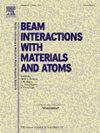Optimization of discharge cavity for transient hollow-cathode electron beam source: Enhancing efficiency and stability in material irradiation processing
IF 1.4
3区 物理与天体物理
Q3 INSTRUMENTS & INSTRUMENTATION
Nuclear Instruments & Methods in Physics Research Section B-beam Interactions With Materials and Atoms
Pub Date : 2025-04-29
DOI:10.1016/j.nimb.2025.165720
引用次数: 0
Abstract
To improve the efficiency of the nanosecond-pulsed electron beam for material irradiation processing, a systematic experimental study of the evolution parameters of the discharge plasma is conducted. A new design is put into practice by stacking and isolating the insulating sheets while the anomalous discharge properties, typically the flashover discharge from the beam source, are investigated experimentally. The improved design raises the total hold-off voltage of the apparatus and enhances electron beam-generating stability. Furthermore, it is shown that when the breakdown voltage is increased from 12 kV to 20 kV, the inductance decreases from 356 nH to 323.1 nH, and the resistance of the discharge cavity ranges between 3.8 Ω and 3.7 Ω. The experimental results further demonstrate that the cathode hole-induced shift in gas pressure significantly alters the discharge pattern. In comparison to the glow discharge, there is a noticeable rise in the discharge current and a significant compression in the breakdown time. Conversely, the size effect on discharge is reduced when the hollow cathode cavity length is beyond a certain threshold. As indicated by the experimental studies, transient current variations are the primary cause of the electromagnetic radiation property of the hollow-cathode discharge beam source.
瞬态空心阴极电子束源放电腔的优化:提高材料辐照加工的效率和稳定性
为了提高纳秒脉冲电子束辐照处理材料的效率,对放电等离子体的演化参数进行了系统的实验研究。在实验研究异常放电特性的同时,提出了一种新的绝缘片叠置隔离设计方法。改进后的设计提高了装置的总抑制电压,增强了电子束产生的稳定性。当击穿电压从12 kV增加到20 kV时,放电腔的电感由356 nH减小到323.1 nH,放电腔的电阻在3.8 Ω ~ 3.7 Ω之间。实验结果进一步表明,阴极空穴引起的气体压力变化显著改变了放电模式。与辉光放电相比,放电电流明显增加,击穿时间明显缩短。相反,当空心阴极空腔长度超过一定阈值时,尺寸对放电的影响减小。实验研究表明,瞬态电流变化是影响空心阴极放电束流源电磁辐射特性的主要原因。
本文章由计算机程序翻译,如有差异,请以英文原文为准。
求助全文
约1分钟内获得全文
求助全文
来源期刊
CiteScore
2.80
自引率
7.70%
发文量
231
审稿时长
1.9 months
期刊介绍:
Section B of Nuclear Instruments and Methods in Physics Research covers all aspects of the interaction of energetic beams with atoms, molecules and aggregate forms of matter. This includes ion beam analysis and ion beam modification of materials as well as basic data of importance for these studies. Topics of general interest include: atomic collisions in solids, particle channelling, all aspects of collision cascades, the modification of materials by energetic beams, ion implantation, irradiation - induced changes in materials, the physics and chemistry of beam interactions and the analysis of materials by all forms of energetic radiation. Modification by ion, laser and electron beams for the study of electronic materials, metals, ceramics, insulators, polymers and other important and new materials systems are included. Related studies, such as the application of ion beam analysis to biological, archaeological and geological samples as well as applications to solve problems in planetary science are also welcome. Energetic beams of interest include atomic and molecular ions, neutrons, positrons and muons, plasmas directed at surfaces, electron and photon beams, including laser treated surfaces and studies of solids by photon radiation from rotating anodes, synchrotrons, etc. In addition, the interaction between various forms of radiation and radiation-induced deposition processes are relevant.

 求助内容:
求助内容: 应助结果提醒方式:
应助结果提醒方式:


